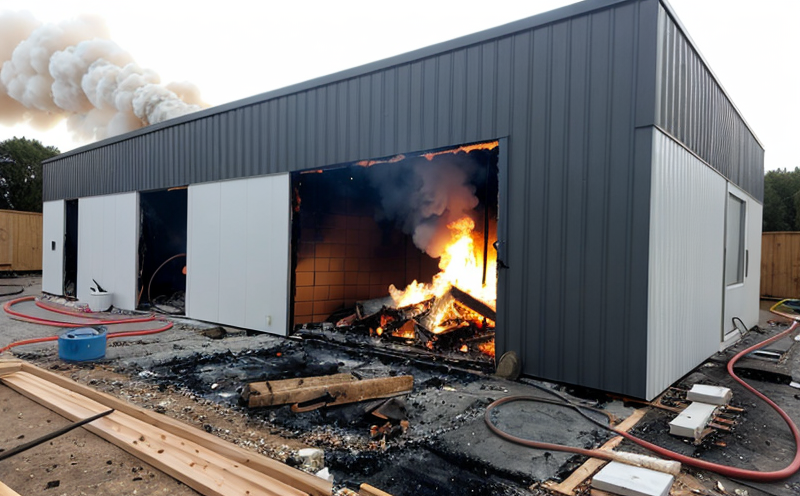BS 476-7 Surface Spread of Flame
The BS 476-7 standard is a critical part of fire safety testing, focusing specifically on the surface spread of flame. This test evaluates how materials and products perform when exposed to an ignition source, assessing their tendency to spread flames across their surfaces.
Developed by the British Standards Institution (BSI), this standard plays a pivotal role in ensuring that building materials do not contribute significantly to the risk of fire spread within structures. The BS 476 suite of tests is widely recognized and used globally, particularly in the construction industry where fire safety is paramount.
The test involves subjecting a specimen to an ignition source for a specified duration, typically 10 minutes, under controlled conditions. The flame is then observed as it spreads across the surface of the material. The performance of the material is rated based on its resistance to the spread of fire and its ability to self-extinguish once the source has been removed.
The test methodology includes various parameters that are crucial for accurate and reliable results:
- Specimen preparation: Materials must be cut into standard sizes, typically 600mm x 300mm, with a thickness of 25mm.
- Ignition source: A gas flame or other specified ignition method is used to start the fire on one edge of the specimen.
- Duration: The test runs for exactly 10 minutes unless self-extinguishment occurs earlier.
- Observation: During the test, the surface spread of flame and any movement are carefully observed and recorded.
The results of this test are essential for architects, engineers, and construction professionals to ensure that materials meet fire safety regulations. Compliance with BS 476-7 can significantly enhance a building's overall fire safety performance, thereby protecting lives and property.
Understanding the implications of failing or passing this test is crucial:
- Pass: The material demonstrates acceptable behavior in terms of flame spread. This means it does not pose an undue risk of contributing to rapid fire spread within a structure.
- Fail: If the material fails, it indicates that it could potentially contribute to more rapid and extensive fire spread under real-world conditions, necessitating further investigation or alternative materials.
Eurolab Advantages
Eurolab is committed to providing comprehensive and reliable testing services that meet the highest international standards. Our expertise in fire safety testing, particularly with BS 476-7, ensures that we offer unparalleled quality and accuracy:
- Comprehensive Knowledge: Eurolab’s team of experts has extensive experience in conducting fire safety tests across various sectors.
- State-of-the-Art Facilities: Equipped with the latest testing equipment, our labs ensure that all tests are conducted under controlled and replicable conditions.
- Consistency: Our rigorous quality control processes guarantee consistent results, which is critical for regulatory compliance.
- Timely Delivery: Eurolab prioritizes customer satisfaction by delivering reports within agreed-upon timelines.
- Comprehensive Reporting: We provide detailed and actionable insights in our test reports, aiding decision-makers in selecting the right materials for their projects.
By choosing Eurolab, you can be confident that your testing needs are met with precision and reliability. Our commitment to excellence ensures that you receive accurate results that can help you make informed decisions regarding material selection and compliance.
Why Choose This Test
- Comprehensive Compliance: Ensures strict adherence to BS 476-7 standards, a key requirement for many regulatory bodies worldwide.
- Accurate Results: Our testing services deliver precise and reliable results that can be trusted in decision-making processes.
- Expertise: Eurolab’s team of experts ensures that the tests are conducted with the highest level of expertise, providing valuable insights for material selection.
- Innovation: Leveraging cutting-edge technology and methodologies to deliver state-of-the-art testing services.
- Customer Satisfaction: Eurolab prioritizes timely delivery and comprehensive reporting to ensure customer satisfaction.
Competitive Advantage and Market Impact
Eurolab’s proficiency in conducting BS 476-7 tests provides a significant competitive advantage, especially for companies operating within the construction and fire safety sectors. By ensuring that materials meet stringent fire safety standards, Eurolab helps clients gain a reputation for quality and reliability.
The results of these tests can have a profound impact on market perception and trust. Compliance with international standards like BS 476-7 not only ensures regulatory compliance but also enhances the credibility of products in the marketplace. This, in turn, can lead to increased sales and broader market acceptance.
For R&D engineers and quality managers, Eurolab’s services provide valuable insights into material performance under fire conditions. These data points are crucial for continuous improvement and innovation within product development cycles.





